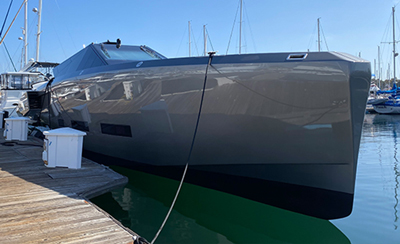DIY’ers should take the right precautions when detailing a boat, from the foam flooring to the external surfaces. It is not easy!
Mostly due to the gel coating that manufacturers employ to make the surface smooth and weatherproof, which with time, can dissolve and make details difficult.
It takes a lot of time and effort to detail a yacht completely. There are several “how to wash a boat yourself” guidelines available, in addition to the equipment that can aid.
Figure a few hours or days for a complete cleaning. Detailing services will be offered by boatyards, dealers, and mobile services. Depending on the services you need and the size of your boat, the cost of hiring a professional might range widely, reaching more than $40 per foot, and the cost can add up quickly.
Keeping that cost in mind, the following are some tips for boat detailing that you can try out yourself. As a marine air conditioning specialist, we see all sizes and vessels. The clean boats are definitely the ones that make us feel more at home, comfortable, and invited. A dirty ship is not only an eye sore but it can be a health and safety hazard. We hope these tips help your boat to be detailed more effectively.
1. Wash and Polish the Boat
You should wash your boat as often as possible.
 For your deck, use premium, natural sea soap. If you have a DEKit floor decking system, this kind of foam flooring has to be cleaned using a detergent that is safe for use on decks to maintain its excellent condition.
For your deck, use premium, natural sea soap. If you have a DEKit floor decking system, this kind of foam flooring has to be cleaned using a detergent that is safe for use on decks to maintain its excellent condition.
Prepare additional cleaning supplies and tools, including:
- A soft-bristle brush
- Large bucket
- Mop
- Washing pad
- Sponge
- Towel
- Chamois cloth for polishing
Prepare polish and wax so you can later enhance your boat’s finish. A vacuum cleaner would also be useful to get rid of tenacious debris from your yacht’s interior tables, counters, and difficult-to-reach areas. Additionally, make sure you have a hose or pressure washer, gel coat protectant, and stain remover.
2. Boat Wax or Sealant
Most boat owners don’t think much about this, but your choice can make all the difference.
Both waxes and sealants are intended to shield the surface of your boat from things like UV radiation, dirt, and salt. Although sealants once got a bad rap for being abrasive, they have improved significantly since then and are now simpler to use.
As they dry, they harden to a finish that lasts the full season and fill the pores in the gel coat. However, using a sealer designed for gel coat finishes is crucial. It shouldn’t be abrasive and should contain a micro-cleaning or polishing ingredient. Use only automotive sealants that clearly state they may be applied to surfaces with a gel coat.
3. Try to Never Air Dry
Allowing your boat to air dry is one of the worst things one can do for the boat. That’s because this will result in the growth of unattractive patches and soap stains. If you’re going to put in the time and effort to detail your boat, you should do well. To avoid that from happening, following a thorough cleaning, dry your boat well using an absorbent cloth, such as a PVA cloth.
Whether you are the proud owner of a cruiser or a sailboat, it pays to pay attention to detail when you are boat detailing, or else you could end up with “breaking out another thousand” or (BOAT).
Comment below with your boat detailing tips.


Absolutely! Mastering the art of boat detailing is crucial for maintaining your vessel’s appearance and protecting it from the elements